Hendrick Frans van Lint stands as a significant figure in the landscape painting tradition of the early 18th century. Born in Antwerp but spending the vast majority of his prolific career in Rome, he became one of the most sought-after painters of Italianate landscapes and Roman city views, known as vedute. His work skillfully blends the meticulous detail often associated with Northern European art with the luminous atmosphere and classical grandeur inspired by the Italian environment and its artistic heritage. His long and successful career in Rome cemented his reputation, leaving behind a rich legacy of works admired for their technical finesse and serene beauty.
Early Life and Training in Antwerp
Hendrick Frans van Lint was born in the bustling artistic center of Antwerp in 1684. His initial artistic training took place in his hometown. Records indicate that during the years 1696 to 1697, he was briefly apprenticed to Pieter van Bredael. Van Bredael himself was a respected painter, known for his landscapes and market scenes, often populated with numerous figures and animals, working in a style that carried echoes of earlier Flemish traditions. This early, albeit short, period of study under Van Bredael would have provided Van Lint with a foundational understanding of composition and technique within the Flemish school.
While some sources might speculatively mention other potential influences or teachers, such as the earlier Mannerist painter Frans Floris, the documented evidence points firmly towards Pieter van Bredael as his formal master during this formative period in Antwerp. This grounding in the Antwerp school's practices likely instilled in him a discipline for careful observation and detailed rendering that would remain visible even as his style evolved under the Italian sun.
The Journey to Rome and a Lifelong Stay
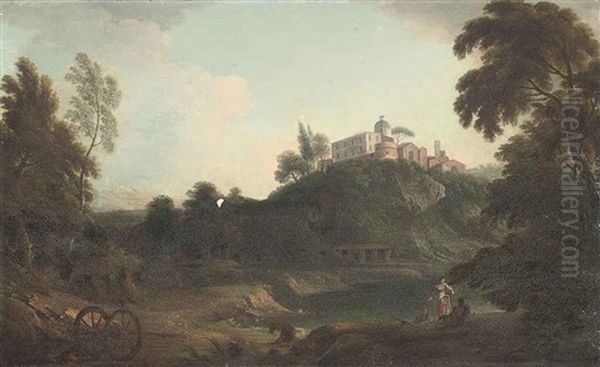
Like many Northern European artists before and after him, Van Lint felt the powerful allure of Italy, particularly Rome, the epicenter of the classical world and a vibrant hub for contemporary art. Around the year 1700, still a young man likely in his late teens, he made his first journey south to the Eternal City. This move proved decisive for his artistic development and career trajectory. Rome offered not only the study of ancient monuments and Renaissance masterpieces but also a thriving community of international artists.
His connection to his homeland was maintained, as evidenced by a return trip to Antwerp around 1710, believed to have been occasioned by the death of his mother. However, this visit was temporary. Soon after, Van Lint returned to Rome, this time establishing himself permanently. From roughly 1710 until his death in 1763, Rome would be his home and the primary subject of his artistic output. He fully integrated into the city's artistic life, dedicating the next five decades to capturing its landscapes and cityscapes.
Development of a Luminous Style
In Rome, Hendrick Frans van Lint specialized primarily in landscape painting, becoming particularly renowned for his vedute, or detailed view paintings. His style is characterized by exceptionally fine brushwork, allowing for a high degree of detail in foliage, architecture, and figures. He possessed a remarkable sensitivity to light and atmosphere, often bathing his scenes in a soft, clear illumination that contributes to a sense of tranquility and order.
His depictions of the Italian countryside, known as the Campagna, often feature rolling hills, meandering rivers, and picturesque villages under expansive skies. He masterfully handled perspective and composition, creating balanced and harmonious views that invited the viewer into the scene. The overall impression of his work is one of serene beauty, meticulous observation, and a deep appreciation for the Italian landscape, both natural and man-made.
The Enduring Influence of Claude Lorrain
A defining characteristic of Van Lint's work is the profound influence of the earlier French master Nicolas Poussin and, perhaps even more significantly, Claude Lorrain (Claude Gellée), who had also spent most of his career working in Rome a century earlier. Van Lint clearly studied Claude's approach to landscape painting, absorbing his techniques for rendering light and atmosphere, and adopting his penchant for idealized, pastoral scenes.
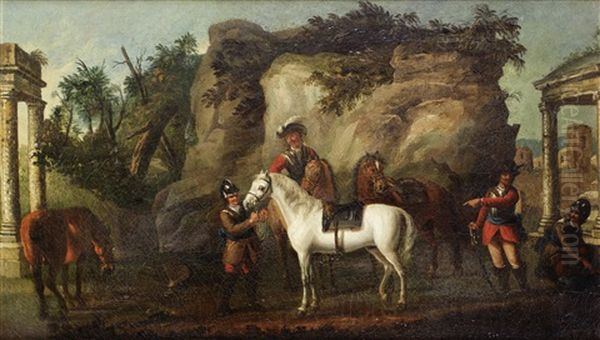
Following Claude's example, Van Lint frequently incorporated classical ruins, ancient temples, and mythological or biblical figures into his landscapes. These elements served not just as picturesque details but also evoked a sense of Arcadian nostalgia and the grandeur of antiquity. His works often present an idealized vision of the Roman Campagna, blending topographical accuracy with a poetic sensibility inherited from Claude Lorrain, creating landscapes that felt both real and timelessly beautiful.
Vedute Painting and Gaspar van Wittel
While adept at idealized landscapes, Van Lint also excelled in the genre of the veduta, the detailed topographical view painting, which gained enormous popularity in the 18th century, particularly among Grand Tour travelers. In this area, he worked alongside, and was likely influenced by, Gaspar van Wittel (often Italianized as Vanvitelli). Van Wittel, originally from the Netherlands, was a key pioneer of the Roman veduta genre, known for his precise and light-filled depictions of city squares, monuments, and panoramic views.
Van Lint's association with Van Wittel placed him at the heart of Roman view painting. He produced numerous detailed and accurate depictions of famous Roman landmarks and vistas. His skill in rendering architecture with precision, combined with his characteristic handling of light, made his vedute highly sought after. He captured the city's unique blend of ancient ruins, Baroque churches, and bustling contemporary life. It is worth noting that Gaspar van Wittel himself collaborated with other artists, such as Abraham Genoels, indicating the interconnected nature of the artistic community.
Life Among the 'Bentvueghels'
Upon arriving in Rome, Van Lint became involved with the Schildersbent, more famously known by their nickname, the 'Bentvueghels' (Dutch for 'birds of a feather'). This was an informal association or brotherhood primarily composed of Dutch and Flemish artists working in Rome. Founded in the 17th century, it provided a social and professional network for these expatriate artists, known for its convivial gatherings and sometimes boisterous initiation rituals.
Membership in the Bentvueghels connected Van Lint with a community of fellow Northerners navigating the Roman art scene. This network facilitated friendships, collaborations, and the exchange of ideas. It underscores his integration into the expatriate artist community, which played a vital role in the cultural life of Rome during this period.
Collaborations and Artistic Friendships
The Roman art world of the 18th century often involved collaboration between artists specializing in different areas. Hendrick Frans van Lint participated in this practice. As noted, his association with Gaspar van Wittel was significant. He also maintained friendships and likely professional relationships with other prominent artists in Rome.
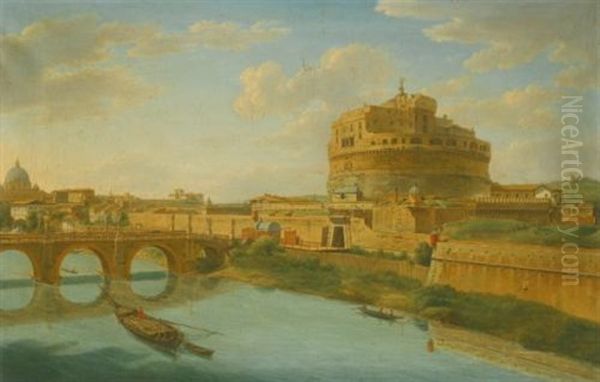
Among his notable contemporaries and friends was Jan Frans van Bloemen, another Flemish landscape painter highly successful in Rome, who earned the nickname 'Orizzonte' for his expansive landscape views. Jan Frans often worked with his brother, Pieter van Bloemen, who specialized in painting figures and animals, often adding staffage to Jan Frans's landscapes. Van Lint himself was known to sometimes collaborate, potentially adding atmospheric backgrounds or landscape settings for figure painters, a common practice that allowed artists to play to their respective strengths.
Masterpieces of Roman Scenery
Van Lint's oeuvre includes numerous depictions of Rome and its surroundings. One particularly notable work mentioned is a large panoramic view of the Roman Forum, commissioned in 1715. This painting is significant not only for its detailed depiction of the Forum as it appeared in the early 18th century, stretching from the Basilica of Maxentius (mistakenly identified as the Temple of Peace) towards the Capitoline Hill, but also for its reported excellent state of preservation.
He also frequently painted views featuring St. Peter's Basilica and the Vatican complex, capturing the grandeur of Bernini's colonnade and Michelangelo's dome from various perspectives. Views of the Castel Sant'Angelo, the Piazza Navona, the Piazza del Popolo, and the Tiber River with its bridges were also common subjects. These works showcase his skill in rendering complex architectural ensembles and capturing the unique light and atmosphere of the city.
Idealized Landscapes and Pastoral Visions
Alongside his topographical vedute, Van Lint continued to produce idealized landscapes throughout his career. Works such as the one titled Paesaggio ideale (Ideal Landscape) exemplify this aspect of his production. These paintings often depict serene, imaginary scenes set in the Italian countryside, featuring gentle hills, calm waters, classical structures (sometimes intact, sometimes ruined), and small figures engaged in pastoral activities.
These ideal landscapes demonstrate his mastery of composition, perspective, and the Claudian tradition of landscape painting. They emphasize harmony, tranquility, and a nostalgic longing for a golden age, appealing to the sensibilities of patrons who admired classical culture and the beauty of the Italian landscape as interpreted through an Arcadian lens.
Other Notable Works and Market Appeal
Van Lint's works are found in numerous public and private collections today. An example held in a major museum is A Landscape with an Italian Hill Town, housed in the National Gallery of Art in Washington D.C., dated broadly to the first quarter of the 18th century (c. 1700-1726). This painting showcases his ability to combine detailed observation of a specific location (even if generalized) with an atmospheric and pleasing composition.
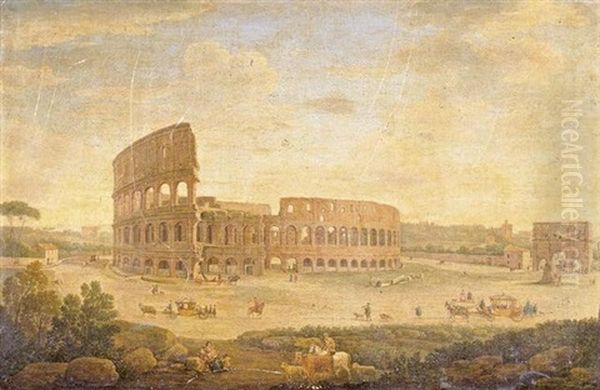
His paintings were popular during his lifetime and have remained desirable on the art market. An example illustrating this is a work titled Soldiers Preparing their Horses, an oil on canvas measuring approximately 36.3 x 60 cm, which appeared at auction with an estimate of £3,000 to £5,000. This indicates the continued appreciation for his skillful execution and charming subject matter among collectors.
Later Years and Enduring Legacy
Hendrick Frans van Lint remained active as a painter in Rome for over half a century, dying in the city in 1763. While highly successful for much of his career, some anecdotal accounts suggest he may have faced financial difficulties in his later years, although concrete details are scarce. Regardless of his personal circumstances towards the end of his life, his artistic legacy was secure.
He is remembered as one of the foremost landscape and veduta painters active in Rome during the first half of the 18th century. He successfully synthesized his Northern European training in detailed observation with the Italian tradition of idealized landscape and the specific demands of topographical view painting. His luminous, meticulously crafted views of Rome and the Campagna captured the imagination of his contemporaries, especially Grand Tourists, and continue to be admired for their elegance, detail, and evocative atmosphere.
Van Lint in Museum Collections
Works by Hendrick Frans van Lint can be found today in various international museums and galleries. As previously mentioned, the National Gallery of Art in Washington D.C. holds examples of his work, such as A Landscape with an Italian Hill Town. His paintings are represented in other collections that focus on European Old Masters, particularly those specializing in Italianate landscapes or Roman vedute.
Clarifying Collections: The Leiden Collection
It is important to note, based on the available information, that Hendrick Frans van Lint's works are not typically found in certain specialized collections. For instance, The Leiden Collection, while being one of the largest private collections of Dutch Golden Age art, focuses primarily on 17th-century masters from Leiden and other Dutch centers. Its core holdings feature artists like Rembrandt van Rijn, Johannes Vermeer, Frans van Mieris, and Gerrit Dou, rather than 18th-century Flemish painters active in Rome like Van Lint or Utrecht Caravaggisti like Hendrick ter Brugghen, who is also represented in that collection.
Clarifying Collections: The Rijksmuseum
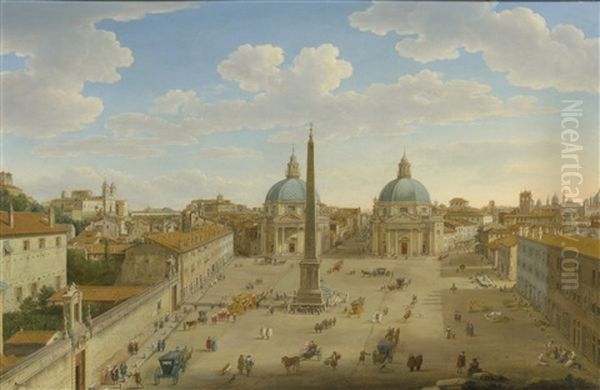
Similarly, the renowned Rijksmuseum in Amsterdam, the national museum of the Netherlands, holds an unparalleled collection of Dutch art, particularly from the 17th century Golden Age. While it showcases masterpieces by Rembrandt, Vermeer, Jan Steen, and Frans Hals, it does not appear to count works by Hendrick Frans van Lint among its primary holdings, as his career unfolded largely outside the Netherlands and belongs to a slightly later period and different stylistic current (Italianate landscape/veduta).
Conclusion: A Luminous Vision of Italy
Hendrick Frans van Lint carved a distinct and respected niche for himself within the vibrant artistic milieu of 18th-century Rome. As a Flemish artist who embraced Italy, he became a master interpreter of its landscapes and cityscapes. Influenced by the great Claude Lorrain yet developing his own refined style, he excelled in both idealized pastoral scenes and detailed topographical vedute. His works, characterized by meticulous detail, harmonious compositions, and a signature soft, clear light, captured the beauty and grandeur of Rome and the surrounding Campagna for an eager audience. He remains an important figure in the history of landscape painting and a key chronicler of the enduring allure of Italy.